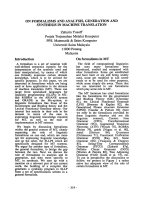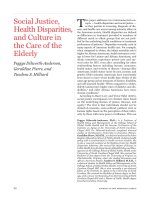HIT TWO BIRDS WITH ONE STONE: IDIOMS AND CULTURE IN FL TRANSLATION CLASS ĐIỂM CAO
Bạn đang xem bản rút gọn của tài liệu. Xem và tải ngay bản đầy đủ của tài liệu tại đây (675.04 KB, 20 trang )
<span class="text_page_counter">Trang 1</span><div class="page_container" data-page="1">
بيرعلا لماعلا في ةييزكلنالا ةغللا لةمج
AWEJ Volume.4 Number.4, 2013Pp.265 -284
<b>Hit Two Birds with One Stone: Idioms and Culture in FL Translation Class </b>
Ahlam Mohammad Alharbi Taif University, Saudi Arabia
<b>Abstract: </b>
A foreign language (FL) translation class should be invested in teaching translation as well as pragmatic competence including culture. The current study has suggested a multilayered method of teaching idioms and culture in FL translation class to provide learners with the required background to communicate successfully. Idioms are one of the important aspects to achieve a successful communication in L2, because it is cultural-oriented, need different methods of translation, and enrich the pragmatic competence of L2 learners. This study has suggested a comparative method in FL translation class to achieve the previous aims. The comparison between the idiomatic expression of L1 (Arabic) and L2 (English) has revealed interesting subclasses of comparison based on cultures, which also indicate the different translation tactics in translating English idioms into Arabic. The subclasses are identical idioms, cultural-semi-identical idioms, cultural-equivalent idioms, and cultural-specific idioms.
<i><b>Keywords: Idioms and culture in FL translation class, Cultural-identical idioms, Cultural-semi-identical idioms, Cultural equivalent idioms, Cultural-specific idioms. </b></i>
</div><span class="text_page_counter">Trang 2</span><div class="page_container" data-page="2">Hiddas Henry
Pramoolsook & Qian
<b>1. Introduction </b>
The purpose of learning a new language is diverse; yet, good communication skills are essential. Successful communication, as Kramsch (1994: 2) explains, involves ―learning how to use words, rules and knowledge about language and its use in order to communicate with speakers of the language‖. This way of looking at language views a language not only as a body of knowledge but also as a social practice (p. 2). Similarly put, as Nyyssonen (1999: 160) claims, ―communicative [or pragmatic] competence is a highly complex ability. It includes grammatical accuracy, intelligibility and acceptability, contextual appropriateness and fluency.‖ Moreover, communication, according to Çakir (2006: 137), ―is functional, purposive and designed to bring about some effect on the environment of hearers and speakers.‖ Hence, second language (L2) learners are required ―to understand the purpose of communication, developing an awareness of what the purpose of a communicative act is and how to achieve that purpose through linguistic forms‖ (Çakir, 2006, p. 137).
Needless to say, most L2 learners are encouraged at schools and, especially, universities to use the foreign language for successful and effective communication. Yet, it has been noted that most of the L2 learners fail in achieving such a goal (see e.g., Lo Bianco 2009, Calviño 2011, McDougald 2009, Li 2013), especially university level learners. Cook (1995: 52) argues, ―[m]any L2 learners achieve only minimal L2 competence after long years of struggle and effort.‖ The researcher has noticed that L2 learners sometimes cannot express themselves in the second language effectively, perhaps, because they do not possess certain degree of pragmatic and communicative competence of the target language. This problem, as Tran (2012: 76) explains, ―may come from the lack of idiomatic phrases in teaching and learning English whereas idiomatic expressions are of great popularity in English in use.‖ Similarly, Barcroft (2012: 1) adds, ―[a]dvanced L2 learners also suffer from limited vocabulary knowledge, such as when it comes to their command of idiomatic expressions.‖ On the other hand, this problem also may be due to the fact that the focus in the learning process is on feeding EFL learners with rules, forms, and decontextualized sentences. However, it is well known that the focus on form should be supplemented by the study of function in context to enrich the students‘ vocabulary and promote successful communication. Hence, it has been argued that teaching fixed expressions and lexical chunks such as idioms to EFL learners especially at the university level may help enhance their pragmatic competence (e.g., Yorio, 1989, Duquette, 1995; Schmitt, 2004). Such research indicates that the proficiency level of L2 learners can be shown through his mastery of idioms and there is a positive correlation between the number of idioms memorized and the success of L2 learners in communicative tasks. In the same vein, as Lewis (1997:15) points out, ―fluency is based on the acquisition of a large store of fixed and semi-fixed prefabricated items.‖ Such fixed expressions can also be ―retrieved and processed as whole units, which may not only enhance the accuracy and fluency of the language, but also speed up language processing significantly‖ (Zhao, 2009, p. 1). Zhao (2009: 10) further explains that a number of studies indicate that such fixed phrases are helpful to L2 learners not only because they increase their motivation but also because they ―contribute to the aspect of language fluency, accuracy, creativeness and cohesion to a large extent.‖
In essence, the significance of idioms in everyday language cannot be over looked. Copper (1998) argues that the native English speaker uses about twenty million idioms in his lifetime of sixty years, which means each speaker uses 356,720 idioms a year (i.e., 980 idioms a day and almost five idioms a minute). These statistics indicate the importance of idiomatic expressions in the daily language use of L2 learners (Tran, 2012, p. 76). In addition, Tran (2012:
</div><span class="text_page_counter">Trang 3</span><div class="page_container" data-page="3">Hiddas Henry
Pramoolsook & Qian
76-77) explains that the idiomatic competence is one of the pivotal criteria for IELTS speaking score, as they are considered ―as indicators for the use of lexical resource in bands 7, 8 and 9.‖ With reference to other significant aspects of idioms, idioms are culture-bound expressions; they ―contain rich, unique features of the language and culture‖ (Zhang, 2009, p. 2). Thus, they can enrich their knowledge of the culture of the target language as well. Furthermore, teaching L2 learners idioms can emphasize and highlight some historical, social, and linguistic issues. By learning idioms, L2 learners will be able to identify issues that English-speaking people are sensitive to such as ethnicity, religion, gender, death, just to mention a few, and also learn the strategies to avoid offending people and enable them to express themselves. Needless to say, cultural knowledge is one of the necessary aspects of forming communicative competence and an educational objective in itself. In other words, it is one of the necessary aspects ―of communicative competence but an educational objective in its own right‖ (Agbedo, 2008, p. 9). It is difficult to detach language from its cultural identity. That is, one language cannot give the same meanings of another because sometimes there is a distinction between the meanings built in a sentence and the meanings that must be expressed. In this sense, each language predisposes and forces its speakers to think differently, i.e., direct their attention to different aspects of the environment.
In short, the significance of teaching idioms is not a hypothesis any more. In fact, according to Fernando (1996), ―[n]o translator or language teacher can afford to ignore idioms or idiomaticity if a natural use of the target language is an aim‖ (p. 234). Idioms, according to Chen and Lai (2013: 13), ―have long been regarded as problematic for L2 learners due to the arbitrariness of their meanings and forms. Traditional methods of teaching idioms focus on rote learning and memorization.‖ In the same vein, Zhang (2009: 1-2) explains, ―L2 idiom learning constitutes a difficult part in second language acquisition because idioms are word collocations with figurative meanings that cannot be easily predicted from the literal meanings of their constituent parts.‖ In practice, the researcher has noticed that teaching fixed phrases such as idioms at the university level has been problematic and could be boring as well. As Cook (1995: 52) argues, ―[a] main goal for second language acquisition research is seen as explaining this dismal failure.‖ Thus, the current study suggests a method of integrating teaching idioms in foreign language (FL) translation class through which learners may learn form, meaning, and new uses; it is worth to note that these dimensions refer to syntax, semantics, and pragmatic
<i>respectively. In so doing, the researcher hits two birds with one stone, i.e., teaching different </i>
methods of translation (to solve the problem of translating idioms) and at the same time teaching idioms and culture of the foreign language. According to the researcher, the translation class is one of the suitable classes to teach such material. It is worth to note that Rostamzadeh (2008: 10) argues that translation class can be invested to improve foreign language competence. Similarly, ―translation class can be evolved by exploring the culture-bound Englishness‖ (Kao, 2009: 1). Through teaching idioms in FL translation class, the researcher attempts to make the translation class as a class in which ―students and teachers are active at the same time‖ (Jakobsen, 1994: 147). FL translation class is also the ideal class, because bilingual competence is needed to invest L1 knowledge as well as control L1 interference.
<b>2. Translation and Culture </b>
More often than not, translation in FL classes gives the learners the wrong impression about the concept of translation. Most of L2 learners perceive it as a matter of finding similar words that carry the same meaning disregarding the cultural differences between the two
</div><span class="text_page_counter">Trang 4</span><div class="page_container" data-page="4">Hiddas Henry
Pramoolsook & Qian
languages and the appropriate way to say the same thing in another language. This linear perspective may result in inaccurate translations. Below is a diagram (Fig. 1) that clarifies the task of a translator viewing translation as transferring the meaning in the appropriate way in the
<b>receptor language. </b>
<i>Fig. 1Overview of Translation Task<sup>1</sup></i>
Catford (1965: 20) defines translation as ―the replacement of textual material in one language by equivalent textual material in another language.‖ Similarly put, Newmark (1981: 7) defines translation as ―a craft consisting in the attempt to replace a written message and/or statement in one language by the same message and/or statement in another language.‖ Hence, ―the linguistic competence is a necessary condition, but not yet sufficient for the professional practice of translation‖ (Badawi, 2008, p. 5). More accurately, as Karamanian (2002) puts it, ―translation, involving the transposition of thoughts expressed in one language by one social group into the appropriate expression of another group, entails a process of cultural de-coding, re-coding and en-coding‖. She suggested the term ―transcoding‖ to refer to the process that focuses ―not merely on language transfer but also—and most importantly—on cultural transposition‖. Newmark (2001: 328) indicates, ―whilst some see culture as the essence of translation, I see culture as the greatest obstacle to translation, at least to the achievement of an accurate and decent translation.‖ Similarly put, in practice, according to Badawi (2008: 3), ―translating the cultural aspects of any source language is not an easy job.‖
It seems that ―differences between cultures may cause more serious problems for the translator than do differences in language structure‖ (Nida 1964:130). Accordingly, Loescher (1991:8) views the translation strategy as ―a potentially conscious procedure for solving a problem faced in translating a text, or any segment of it.‖ Accordingly, this research is an attempt to participate in solving one of the many problems EFL learners and teachers may face in FL translation class and at the same time propose a way of integrating teach culture and language (i.e., idioms) at the same time in FL class. As Badawi (2008: 3) indicates, ―[c]entral to culture and communication is translating culture-bound expressions.‖ Yet, as Badawi (2008: 7) argues, ―the role of culture in translation is marginalized in the research [carried out] in the Arab world. This means that more studies are needed in the area of culture and translation.‖ Furthermore, Badawi (2008: 7-8) notes that the role of culture in translation is also marginalized in most of the available translation programs as well as courses at some Saudi universities. Needless to mention, this problem is widespread problem that faces EFL teachers and learners as well as <small> </small>
<small> This diagram is from Larson (1998, p.4) </small>
</div><span class="text_page_counter">Trang 5</span><div class="page_container" data-page="5">Hiddas Henry
Pramoolsook & Qian
translators. Badawi (2008: 7-8) notes, ―translating culture-bound expressions is expected to be one of the most nagging translation problems facing EFL prospective teachers at the University of Tabuk, KSA‖ (Badawi, 2008, pp.7-8). I have to admit that this problem is not only confined to the teachers of the University Tabuk; it is a widespread problematic issue. Al-Dosari and Mekheimer (2013) suggest exposing translators as well as learners to ―different socio-linguistic and cultural features of target texts that deal with both the source language and the translation language cultures.‖
In this study, FL translation class is designed so learners can learn idioms through investing their prior knowledge of their first language and analytical power to develop their pragmatic competence and polish their translation skills at the same time. This method can make teaching idioms fun, too. As noted earlier, comparing English and Arabic idioms in translation class can provide a good source for teaching vocabulary, grammar, and culture besides enriching the learners‘ pragmatic competence and teaching them how to translate problematic fixed phrases. In addition, this study suggests a new way of looking at idioms in EF translation class through presenting a new typology of English<>Arabic idioms. The translation of non-literal meaning such as idioms has been viewed as being non-literal translation solely. Yet, a comparison between the idioms of the source language and those of the target language can result in some interesting possible methods of translation depending on the culture of the two languages under investigation. These different methods can be invested in EF translation class to teach different methods of translation as well as enrich the learners‘ vocabulary.
<b>3. Idiomatic Expressions </b>
Cacciari (1993: iii) defines idioms as ―strings of words whose semantic interpretation cannot be derived compositionally from the interpretation of their parts.‖ One of the universal prosperities all languages share is the arbitrary relations between form and meaning. According to Abel (2003: 329), ―idioms are described as fixed expressions, i.e., as phrases or sentences whose figurative meaning is not clear from the literal meaning of their individual constituents.‖ Abkarian et al (1990) explain that Alexander (1984) has highlighted the importance of teaching idioms to L2 learners. They agree with Alexander (1984) regarding ―the close relationship between knowledge of idioms and knowledge of a culture‖ (p. 247).
Some L2 learners believe that idioms are rare; hence, they have been overlooked. Yet, idioms are very common in spoken language (see, Carter and McCarthy, 1997; Cockcroft, 1999). Many idiomatic expressions are used on daily basis. Pollio et al (1977) claimed that almost ―four figures of speech (many of them idioms) are uttered every minute by adult speakers‖ (qtd. in Abkarian, 1990, p. 247). Hence, learners are supposed to memorise such idiomatic expressions, as they do in their native language. Teaching culture through idioms by exploring the historical origin of an idiom, i.e., ‗the fable‘ behind it may offer a logical explanation for L2 learners and keep them motivated as well. Some of the metaphors and the colours used in idioms can provide learners with some information of the culture of the L2, because the metaphors underlying idioms are usually deeply embedded in the culture of the language. In addition, some of the idioms are based on the L2 traditions, festivals, folklore, religion, etc., which can indirectly give L2 learners some insights of the L2 culture providing them with certain degree of competence to enable them to communicate successfully and effectively.
As Chen (2010: 227) puts it, ―[i]dioms are the gems of a language.‖ Hence, translating idioms is not an easy task, especially from English to Arabic because not all English idioms have equivalents in Arabic idioms due to linguistic and cultural differences. To solve the problems of
</div><span class="text_page_counter">Trang 6</span><div class="page_container" data-page="6">Hiddas Henry
Pramoolsook & Qian
<i>translation facing learners, Ghazala (1995) simply divides idioms into three divisions: direct idioms, indirect idioms, and phrasal verbs. However, in the proposed study, the comparison </i>
between English and Arabic idioms has resulted in some new divisions based on culture, which in turn result in different methods of translation. As noted above, these divisions may be used in translation classes in order to teach idioms, culture, and different methods of translation. The
<i>subclasses the present study offers are cultural identical idioms, cultural semi-identical idioms, </i>
<i>cultural equivalent idioms, and cultural specific idioms. Connecting the cultures of two </i>
languages can make the task of the learners easier to memorize these idioms and enjoy doing so. In essence, native speakers do memorize these expressions and it is the same task L2 learners should do. Yet, comparing the two cultures and showing the similarities and the differences can simplify things for them.
Richard-Amato (1996) argues that adult learners ―construct language from prior conceptual knowledge and develop language in predictable stage‖ (qtd. in ZhonggangGoa, 2001, p. 1). In more detail, L2 learners are usually inclined to use their prior knowledge and their analytical power to compare between L1 and L2 consciously and unconsciously. Hence, Richard-Amato (1996) urges teachers for L2 learner to invest these analytical abilities and prior knowledge to enable them to learn a new language easily. This power can be invested and directed to facilitate the process of learning instead of hindering it. Therefore, the current study encourages L2 teachers to invest the prior knowledge of the learners to facilitate the process of teaching and at the same time to control L1 interference. The next section shows some examples of the comparison that can be carried in FL translation class.
<b>4. Data and Methodology </b>
The data of the present study comprises 62 English idioms that were selected randomly from the internet to be taught to L2 learners. The researcher translated these idioms from English into Arabic utilizing different methods of translation. In addition, a transliteration of each idiom is provided. As noted above, these idioms are divided into subclasses based on the cultural aspects which in turn determine the method of translation. This resulted in four subclasses of
<i>idioms; they are cultural identical idioms, cultural semi-identical idioms, cultural equivalent idioms, and cultural specific idioms. It is worth to note that the purposes of the typology of the </i>
present study are threefold: (a) to offer suitable divisions of idioms for translation reasons, (b) to describe the development of idiom comprehension among learners from a cultural perspective, and (c) to suggest some activities to enhance idioms learning as well as cultural comprehension development among L2 learners. The following are the discussion of the subclasses of idioms based on cultures.
<b>5. Typology of Idioms </b>
As mentioned above, in this study there are four subclasses of idioms based on culture and methods of translation. Each subclass is discussed below with examples providing their transliteration and translation when needed.
<b>5.1 Cultural-identical Idioms </b>
Cultural-identical idioms are those idioms that are identical in both languages (i.e., English and Arabic). That is, there are identical idioms in both languages English and Arabic that can be translated following the method of literal translation (word-for-word), because the idioms in this category are completely similar in form (syntax), meaning (semantics), and usage (pragmatics). The following are some examples with their transliteration:
</div><span class="text_page_counter">Trang 7</span><div class="page_container" data-page="7">Hiddas Henry
Pramoolsook & Qian
1. When one wants to tell someone that a person says unpleasant things about him to other people in his absence, one may say:
<b>- behind your back </b>
<b>- /min wara Dahrak/ </b>
2. When one would like to let others know that he found out about a piece of information without naming the person who told him, one may say:
<b>- a little bird told me - /?l؟Sfuurah qaalt lii/ </b>
3. When one is ready and eager to listen to what a person is saying, one may say:
<b>- be all ears </b>
<b>- /Kuuluna ?ðanin Sagyyah/ </b>
4. When one intends to say that something is considered as a very important part of a person and seems natural to him, one may say:
<b>- in your blood - /fii damak/ </b>
5. When one wants to say that something makes him angry, one may say:
<b>- make my blood boil - /xallat damii yigli/ </b>
6. When one wants to indicate that he does not like an action or a plan and will do anything to prevent it, one may say:
<b>- over my dead body - /؟ala juθati/ </b>
7. When one wants to say emphatically that something happens throughout a person‘s life, one may say:
<b>- from the cradle to the grave - /minn ?lmahd iila ?laHd/ </b>
8. When one wants to say that a person pays no attention to things one is saying, or forgets about what has been said immediately, one may say:
<b>- go in one ear and out the other </b>
<b>- /yudxul minn ?uðn wa yuxruj minn ?aθanyyah/ </b>
9. When one is too embarrassed to do something because of something happened, one may say:
<b>- not have the face - /maali wajh/ </b>
10. When one says that something is taken care of by a trustworthy person and therefore it will not be damaged, one may say:
<b>- in safe had </b>
<b>- /fii ?ydii ?miinah/ </b>
11. When one asks a person to keep him aware of changes or developments in any situation, one may say:
<b>- keep me in the picture - /xaliini fii ?Suurah/ </b>
12. When one gets or obtains the largest part of anything leaving very little for others, one may refer to the largest part as being:
<b>- the lion’s share - /naSiib ?l?asad/ </b>
</div><span class="text_page_counter">Trang 8</span><div class="page_container" data-page="8">Hiddas Henry
Pramoolsook & Qian
13. When one sees something without using any equipment such as a telescope, one may say:
<b>- the naked eye </b>
<b>- /bil؟ayyn ?lmuujaradh/ </b>
14. When one sees something and wants to win it, one may say:
<b>- have one’s eye on something - /؟yinii ؟alihaa/ </b>
15. When one is looking for something and he wants to say that it is difficult or even impossible to find it, one may say:
<b>- like looking for a needle in a haystack - /yiidawir ibrah fii kumat qash/ </b>
16. When one asks a person to slow down and not to do something hasty, one may say:
<b>- hold your horses - /ikba jiimaaHk/ </b>
17. When one wants to say that a person does something by means of hard physical work, one may say:
<b>- by the sweat of one’s brow - /bi؟arq jabiinii/ </b>
18. When something bad happens, one sometimes may try to console himself or another person by suggesting that the consequences of the events are not as bad as might seem by saying:
<b>- It is not the end of the world - /mihii nihayat ?l؟aalam/ </b>
19. When one wants to describe a person who does whatever others need to get what he wants, even if it may involve stepping on his principles or doing something wrong, one may say:
<b>- sell ones’ soul - /tiibii؟ ruuHahaa/ </b>
Surprisingly, in both languages, there are such cultural identical idioms. Interestingly, these few examples illustrate the intercourse between Arabic and English and the exchanges of some ideas and concepts. Through translating these idioms, learners can be taught not only a method of translation, i.e., literal (word-for-word) translation, but also such an aspect of language will be a good material to be translated literally to show how cultures of different languages interrelated and intertwined with each other. Idioms in this category can be understood in isolation, because learners will relay on their prior knowledge of L1. This wealth of L1 knowledge of L2 learners can be invested to teach them how to use such already learnt idioms to express themselves in English just as they do in Arabic. Most of the idioms in this category are to a great extent universal and L2 learners need to express themselves in the L2 as fluently and efficiently as they do in their L1. Broadly speaking, L2 learners are already equipped with the cultural-linguistic knowledge their L1 and such idioms are not problematic with reference to first language interference. On the contrary, in this category L2 learners can benefit from first language interference to develop their L2 and help them to know when to avoid such interference.
<b>5.2 Cultural-semi-identical Idioms </b>
</div><span class="text_page_counter">Trang 9</span><div class="page_container" data-page="9">Hiddas Henry
Pramoolsook & Qian
The second subclass is the identical idioms. The idioms in this category are semi-identical, because the translation of these idioms needs to be modified to fit the structure of the idioms in the source/target language. Such idioms can be translated literally; however, one has to take into consideration the L2 culture, which will have its impact on some lexical choices. The following idioms are identical in their meanings; yet, there are some slight differences in the lexical choices:
1. When one wants to refer to a person whom he is fond of, one may say:
<b>- the apple of my eye - /qurat ؟ayinii/ </b>
2. When one criticizes a person, who is making an unimportant problem seem big and important, one may say:
<b>- make a mountain out of a molehill </b>
<b>- /y؟mal minn ?lHabah kubah/ (i.e., make a dome from a seed) </b>
3. When one wants to excuse the way a boy is behaving as being normal for boys to be boyish, one may say:
<b>- boys will be boys </b>
<b>- /Hamiid walad/ (i.e., Hamiid is a boy) </b>
4. When one wants to describe two persons who usually have violent arguments with each other, one may say:
<b>- fight like cat and dog </b>
<b>- /zayy ?lbis wa ?lfaar/ (i.e., like cat and rat) </b>
5. When one wants to describe the policy of a person who is in power and wants stay in power by making sure that the people under his control quarrel among them, one may say:
<b>- divide and rule </b>
<b>- /fariq tasud/ (i.e., divide and dominate) </b>
6. When one wants to say that it is very obvious to people that a person is relieved or miserable, one may say:
<b>- written all over your face </b>
<b>- /bayin ؟ala wajhak/ (i.e., it is clear on your face) </b>
7. When one is criticizing people for talking about unpleasant or personal matters in front of others, one may say:
<b>- wash their dirty laundry in public </b>
<b>- /nasharat gasiilahaa/ (i.e., to hang one’s laundry) </b>
8. When one wants to indicate that a person is in a very bad mood without an obvious reason, one may say:
<b>- get up on the wrong side of the bed </b>
<b>- /nayim ؟ala janbuh ?lyasar/ (i.e., he/she slept on his/her left side) </b>
9. When one wants to make a fresh new start after a period of difficulties and problems, one may say:
<b>- turn the page </b>
<b>- /nibda? SafHah jadidah/ (i.e., start a new page) </b>
10. When one wants to clarify that it is impossible to be loyal to two opposing principles, ideologies, or organizations, one may say:
<b>- cannot serve two masters </b>
<b>- /SaaHib balayn kaðaab/ (i.e., who has two minds is a liar) </b>
</div><span class="text_page_counter">Trang 10</span><div class="page_container" data-page="10">Hiddas Henry
Pramoolsook & Qian
11. In a race or contest, if two competitions are exactly level with each other, one may say:
<b>- neck and neck </b>
<b>- /raas bi raas/ (i.e., head and head) </b>
12. If there is something one doesn‘t understand at all, one says:
<b>- be all Greek to me - /Talaasm/ (i.e., mystery) </b>
13. If one wants to say to someone not to remind him of an unpleasant experience in the past that one would rather forget, one may say:
<b>- don’t open old wounds </b>
<b>- /laa tiqaliibii ?lmawaaji؟/ (i.e., do not recall wounds) </b>
14. To say something has both a good and a bad side, one says:
<b>- a double-edge sword </b>
<b>- /silaah ðuu Hadyin/ (i.e., a weapon with two edges) </b>
15. If one intends to say that it is easy to forget about someone or something, or to stop caring about them, when one has not seen them for a long time, one may say:
<b>- out of sight, out of mind </b>
<b>- /?lba؟iid ؟n ?l؟iin, ba؟iid ؟n ?lqalb/ (i.e., away from the sight, away from the heart) </b>
In this category, learners can give the correct translation of the English version depending on their prior knowledge of L1 with some changes regarding some lexical choices. Hence, FL teachers should highlight these differences in regards to the lexical choices. Undeniably, these lexical differences will help them to understand the culture of the target language. To a great extent, learners can use literal translation but they have to modify their translation afterwards. As identical idioms, these idioms can be utilized in EF translation class to invest their first language.
<b>5.3 Cultural-equivalent Idioms </b>
It is common that any two languages can express the same thing in two different ways. Each language has its own differences whether they are arbitrary or non-arbitrary (cultural); however, all languages can express its needs fully. Cultural-equivalent idioms are the ones that their meanings can be found in both languages with different fixed expressions. Thus, the idioms in this category can be found in both languages sharing only the meaning, yet the expression itself is completely different:
1. When one wants to express his sympathy for an unhappy person, poor etc. one may say:
<b>- I feel for you </b>
<b>- /qalbii ma؟aakii/ (i.e., my heart is with you) </b>
2. When one wants to show that he is attracted to a person, one may say:
<b>- make eyes at someone </b>
<b>- /sabal ؟inih/ (i.e., soften his/her eyes) </b>
3. When one wants to say that something makes a person conceited, one may say:
<b>- turn his head </b>
<b>- /kibir ra?suh/ (i.e., he/she makes his/her head big) </b>
4. When one is wants to say that two things are completely different in every aspects, one may say:
<b>- Apples and oranges </b>
<b>- /zyi ?asamaa? wa ?al?rD/ (i.e., like sky and earth) </b>
5. When one gets a piece of information directly from main sources, and so he is sure it is true, one may say:
</div>








